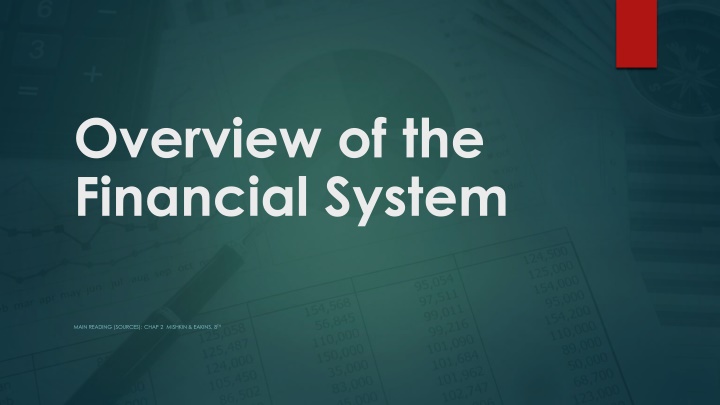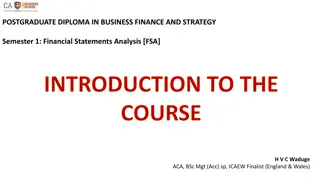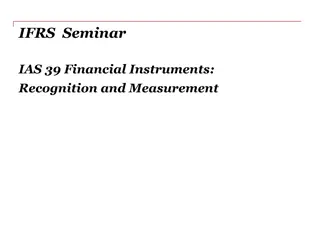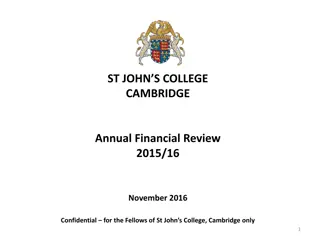
Financial System in an Advanced Economy
Explore the role of the financial system in an advanced economy, including the impact of financial markets, institutions, and intermediaries. Learn about the structure, operations, and regulation of financial markets, as well as the importance of efficient capital allocation for economic growth. Discover how financial intermediation bridges the gap between savers and borrowers, fostering wealth creation and development.
Download Presentation

Please find below an Image/Link to download the presentation.
The content on the website is provided AS IS for your information and personal use only. It may not be sold, licensed, or shared on other websites without obtaining consent from the author. If you encounter any issues during the download, it is possible that the publisher has removed the file from their server.
You are allowed to download the files provided on this website for personal or commercial use, subject to the condition that they are used lawfully. All files are the property of their respective owners.
The content on the website is provided AS IS for your information and personal use only. It may not be sold, licensed, or shared on other websites without obtaining consent from the author.
E N D
Presentation Transcript
Overview of the Financial System MAIN READING (SOURCES): CHAP 2 MISHKIN & EAKINS, 8TH
Chapter Preview In this chapter, we examine the role of the financial system in an advanced economy. We study the effects of financial markets and institutions on the economy, and look at their general structure and operations. Topics include: Function of Financial Markets Structure of Financial Markets Internationalization of Financial Markets Function of Financial Intermediaries: Indirect Finance Types of Financial Intermediaries Regulation of the Financial System
Function of Financial Markets Channels funds from person or business without investment opportunities (i.e., Lender-Savers ) to one who has them (i.e., Borrower-Spenders ) This process - financial intermediation, involves the movement of funds from individuals or businesses that have surplus funds but lack investment opportunities (such as lenders or savers) to those who have investment opportunities but lack funds (such as borrowers or spenders). Financial intermediaries play a crucial role in this process by acting as intermediaries between the two parties, facilitating the flow of funds and enabling economic growth. These intermediaries can include banks, credit unions, mutual funds, and other financial institutions that bring together savers and borrowers, thereby allocating capital efficiently and promoting economic activity. By channeling funds from surplus units to deficit units, financial intermediation helps to bridge the gap between those who have excess funds and those who need them for productive purposes, fostering economic development and wealth creation.
Segments of Financial Markets 1. Direct Finance Borrowers borrow directly from lenders in financial markets by selling financial instruments which are claims on the borrower s future income or assets 2. Indirect Finance Borrowers borrow indirectly from lenders via financial intermediaries (established to source both loanable funds and loan opportunities) by issuing financial instruments which are claims on the borrower s future income or assets
Importance of Financial Markets This is important. For example, if you save $1,000, but there are no financial markets, then you can earn no return on this - might as well put the money under your mattress. However, if a carpenter could use that money to buy a new saw (increasing her productivity), then she is willing to pay you some interest for the use of the funds. Financial markets are critical for producing an efficient allocation of capital, allowing funds to move from people who lack productive investment opportunities to people who have them. Financial markets also improve the well-being of consumers, allowing them to time their purchases better.
Structure of Financial Markets 1. Debt Markets Short-Term (maturity < 1 year) Long-Term (maturity > 10 year) Intermediate term (maturity in-between) 2. Equity Markets Pay dividends, in theory forever Represents an ownership claim in the firm
Structure of Financial Markets 1. Primary Market New security issues sold to initial buyers Typically involves an investment bank who underwrites the offering 2. Secondary Market Securities previously issued are bought and sold Examples include the NYSE and Nasdaq Involves both brokers and dealers (do you know the difference?) We can further classify secondary markets as follows: 1. Exchanges Trades conducted in central locations (e.g., New York Stock Exchange, CBT) 2. Over-the-Counter Markets Dealers at different locations buy and sell Best example is the market for Treasury Securities
Classifications of Financial Markets We can also classify markets by the maturity of the securities: 1. Money Market: Short-Term (maturity < 1 year) 2. Capital Market: Long-Term (maturity > 1 year) plus equities (no maturity)
Internationalization of Financial Markets The internationalization of markets is an important trend. The U.S. no longer dominates the world stage. International Bond Market & Eurobonds Foreign bonds Eurobonds Denominated in one currency, but sold in a different market Now larger than U.S. corporate bond market Over 80% of new bonds are Eurobonds Eurocurrency Market Foreign currency deposited outside of home country Eurodollars are U.S. dollars deposited, say, London. Gives U.S. borrows an alternative source for dollars. World Stock Markets U.S. stock markets are no longer always the largest at one point, Japan s was larger
Internationalization of Financial Markets > FOLLOWING THE FINANCIAL NEWS Foreign Stock Market Indexes Foreign stock market indexes are published daily in newspapers and Internet sites such as www.finance.yahoo.com. The most important of these stock market indices are: Dow Jones Industrial Average (DJIA) An index of the 30 largest publicly traded corporations in the United States maintained by the Dow Jones Corporation. S&P 500 An index of 500 of the largest companies traded in the United States maintained by Standard & Poor s. Nasdaq Composite An index for all the stocks that trade on the Nasdaq stock market, where most of the technology stocks in the United States are traded. FTSE 100 An index of the 100 most highly capitalized UK companies listed on the London Stock Exchange. DAX An index of the 30 largest German companies trading on the Frankfurt Stock Exchange. CAC 40 An index of the largest 40 French companies traded on Euronext Paris. Hang Seng An index of the largest companies traded on the Hong Kong stock markets. Strait Times An index of the largest 30 companies traded on the Singapore Exchange.
Indices and Tracking Market Performance 13 Indices and tracking market performance: A stock market index is a method of measuring the performance of a specific segment of the stock market or economy Price weighted - Dow Jones Industrial Average (DJIA) 30Pit DJIAt= D i=1 Capitalization weighted - Standard & Poor s 500 (S&P 500) Index = Pt.Qt D
How to Trade Stocks 14 Types of Orders Market Orders: Market orders are BUY or SELL orders that need to be executed immediately at the current market price. Limit Orders: Investors may place an order with an instruction to buy or sell at a specific price regardless what the market prices are. Stop Order (Stop-Loss Orders or Stop-Buy Orders): A stop order is like a limit order with a condition to buy or sell at a certain price but differing on the mechanics
Global Perspective: Relative Decline of U.S. Capital Markets The U.S. has lost its dominance in many industries: automobiles and consumer electronics, to name a few. A similar trend appears at work for U.S. financial markets, as London and Hong Kong compete. Indeed, many U.S. firms use these markets over the U.S. Why? 1. New technology in foreign exchanges 2. 9 11 made U.S. regulations tighter 3. Greater risk of lawsuit in the U.S. 4. Sarbanes-Oxley has increased the cost of being a U.S.-listed public company
Function of Financial Intermediaries: Indirect Finance Instead of savers lending/investing directly with borrowers, a financial intermediary (such as a bank) plays as the middleman: the intermediary obtains funds from savers the intermediary then makes loans/investments with borrowers This process, called financial intermediation, is actually the primary means of moving funds from lenders to borrowers. More important source of finance than securities markets (such as stocks) Needed because of transactions costs, risk sharing, and asymmetric information
Function of Financial Intermediaries: Indirect Finance Transactions Costs Financial intermediaries make profits by reducing transactions costs 1. Reduce transactions costs by developing expertise and taking advantage of economies of scale A financial intermediary s low transaction costs mean that it can provide its customers with liquidity services, services that make it easier for customers to conduct transactions 2. Banks provide depositors with checking accounts that enable them to pay their bills easily Depositors can earn interest on checking and savings accounts and yet still convert them into goods and services whenever necessary 1. 2.
Function of Financial Intermediaries: Indirect Finance Another benefit made possible by the FI s low transaction costs is that they can help reduce the exposure of investors to risk, through a process known as risk sharing FIs create and sell assets with lesser risk to one party in order to buy assets with greater risk from another party This process is referred to as asset transformation, because in a sense risky assets are turned into safer assets for investors Financial intermediaries also help by providing the means for individuals and businesses to diversify their asset holdings. Low transaction costs allow them to buy a range of assets, pool them, and then sell rights to the diversified pool to individuals.
Function of Financial Intermediaries: Indirect Finance Another reason FIs exist is to reduce the impact of asymmetric information. One party lacks crucial information about another party, impacting decision-making. We usually discuss this problem along two fronts: adverse selection and moral hazard. Adverse Selection Before transaction occurs Potential borrowers most likely to produce adverse outcome are ones most likely to seek a loan Similar problems occur with insurance where unhealthy people want their known medical problems covered 1. 2. 3.
Asymmetric Information: Adverse Selection and Moral Hazard Moral Hazard After transaction occurs 1. Hazard that borrower has incentives to engage in undesirable (immoral) activities making it more likely that won t pay loan back Again, with insurance, people may engage in risky activities only after being insured 2. 3. Another view is a conflict of interest 4. Financial intermediaries reduce adverse selection and moral hazard problems, enabling them to make profits. How they accomplish this is covered in many of the chapters to come.
Economies of Scope and Conflicts of Interest FIs are able to lower the production cost of information by using the information for multiple services: bank accounts, loans, auto insurance, retirement savings, etc. This is called economies of scope. But, providing multiple services may lead to conflicts of interest, perhaps causing one area of the FI to hide or conceal information from another area (or the economy as a whole). This may actually make financial markets less efficient!
Types of Financial Intermediaries: Depository Institutions Depository Institutions (Banks): accept deposits and make loans. These include commercial banks and thrifts. Commercial banks (about 5,000 at end of 2015) Raise funds primarily by issuing checkable, savings, and time deposits which are used to make commercial, consumer and mortgage loans Collectively, these banks comprise the largest financial intermediary and have the most diversified asset portfolios Thrifts: S&Ls & Mutual Savings Banks and Credit Unions (around 900 of each)
Types of Financial Intermediaries: Contractual Savings Institutions (CSIs) All CSIs acquire funds from clients at periodic intervals on a contractual basis and have fairly predictable future payout requirements. Life Insurance Companies Fire and Casualty Insurance Companies Pension and Government Retirement Funds
Types of Financial Intermediaries: Investment Intermediaries Finance Companies Mutual Funds Money MarketMutual Funds Hedge Funds Investment Banks
Table 2.1 Primary Assets and Liabilities of Financial Intermediaries (1 of 3)
Table 2.1 Primary Assets and Liabilities of Financial Intermediaries (1 of 3)
Table 2.1 Primary Assets and Liabilities of Financial Intermediaries (1 of 3)
Table 2.3 Principal Regulatory Agencies of the U.S. Financial System (1 of 3) Regulatory Agency Subject of Regulation Nature of Regulations Securities and Exchange Commission (SEC) Organized exchanges and financial markets Requires disclosure of information; restricts insider trading Commodities Futures Trading Commission (CFTC) Futures market exchanges Regulates procedures for trading in futures markets Office of the Comptroller of the Currency Federally chartered commercial banks and thrift institutions Charters and examines the books of federally chartered commercial banks and thrift institutions; imposes restrictions on assets they can hold
Table 2.3 Principal Regulatory Agencies of the U.S. Financial System (2 of 3) Regulatory Agency Subject of Regulation Nature of Regulations National Credit Union Administration (NCUA) Federally chartered credit unions Charters and examines the books of federally chartered credit unions and imposes restrictions on assets they can hold Charter and examine the books of state-chartered banks and insurance companies; impose restrictions on assets they can hold; and impose restrictions on branching State banking and insurance commissions State-chartered depository institutions
Table 2.3 Principal Regulatory Agencies of the U.S. Financial System (3 of 3) Regulatory Agency Subject of Regulation Nature of Regulations Provides insurance of up to $250,000 for each depositor at a bank; examines the books of insured banks; and imposes restrictions on assets they can hold Examines the books of commercial banks that are members of the system; sets reserve requirements for all banks Federal Deposit Insurance Corporation (FDIC) Commercial banks, mutual savings banks, savings and loan associations Federal Reserve System All depository institutions
Regulation of Financial Markets Main Reasons for Regulation 1. Increase Information to Investors 2. Ensure the Soundness of Financial Intermediaries
Regulation Reason: Increase Investor Information Asymmetric information in financial markets means that investors may be subject to adverse selection and moral hazard problems that may hinder the efficient operation of financial markets and may also keep investors away from financial markets. The Securities and Exchange Commission (SEC) requires corporations issuing securities to disclose certain information about their sales, assets, and earnings to the public and restricts trading by the largest stockholders (known as insiders) in the corporation. Such government regulation can reduce adverse selection and moral hazard problems in financial markets and increase their efficiency by increasing the amount of information available to investors. Indeed, the SEC has been particularly active recently in pursuing illegal insider trading.
Regulation Reason: Ensure Soundness of Financial Intermediaries (1 of 2) Providers of funds (depositors, like you) to financial intermediaries may not be able to assess whether the institutions holding their funds are sound or not. If they have doubts about the overall health of financial intermediaries, they may want to pull their funds out of both sound and unsound institutions, which can lead to a financial panic. Such panics produces large losses for the public and causes serious damage to the economy.
Regulation Reason: Ensure Soundness of Financial Intermediaries (2 of 2) To protect the public and the economy from financial panics, the government has implemented six types of regulations: Restrictions on Entry Disclosure Restrictions on Assets and Activities Deposit Insurance Limits on Competition Restrictions on Interest Rates
Chapter Summary Function of Financial Markets: We examined the flow of funds through the financial system and the role of intermediaries in this process. Structure of Financial Markets: We examined market structure from several perspectives, including types of instruments, purpose, organization, and time horizon. Internationalization of Financial Markets: We briefly examined how debt and equity markets have expanded in the international setting. Function of Financial Intermediaries: We examined the roles of intermediaries in reducing transaction costs, sharing risk, and reducing information problems. Types of Financial Intermediaries: We outlined the numerous types of financial intermediaries to be further examined in later chapters. Regulation of the Financial System: We outlined some of the agencies charged with the oversight of various institutions and markets.






















